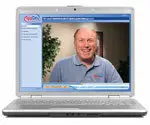AppDev LINQ Using Visual C # 2008 DVD :
In this course, you’ll learn to use the exciting new .NET Framework 3.5 feature, Language Integrated Query (LINQ) to easily create complex data-independent queries. In addition, you’ll learn about the new language features added to Visual Basic in Visual Studio 2008 in order to make LINQ possible. You’ll start by working through a quick overview of LINQ, and how it applies to working with collections of objects, retrieving data stored in SQL Server, and creating XML content. Subsequent topics introduce new LINQ-oriented language features, LINQ to Objects, LINQ to DataSets, LINQ to SQL, LINQ to XML, and LINQ to Entities. By the time you’ve completed the course, you’ll have a good understanding of now only how to construct LINQ queries to work with data, but also how to use the features added to Visual Basic that support LINQ.
In this course, you will learn how to…
* Create new XML content using LINQ to XML.
* Iterate through collections of objects, using a single LINQ query.
* Use anonymous types, lambda expressions, extension methods, object initializers, and implicit type declaration.
* Query arrays, lists, dictionaries, and more using LINQ to Objects.
* Use the extension methods provided by the System.Linq.Enumerable class to extend the behavior of collection classes.
* Create an object model based on a SQL Server database and then query the database using LINQ to SQL.
* Modify data and use stored procedures with LINQ to SQL.
* Create XML content using classes in the System.Xml.Linq namespace.
* Validate, query and transform XML content using LINQ to XML.
* Transform XML content using LINQ to XML.
* Create an Entity Data Model based on a data source and then query the data using LINQ to Entities.
* Modify data and use stored procedures with LINQ to Entities.
Prerequisites: This course assumes that students have familiarity with .NET in general, and with specifically with programming ADO.NET. The course makes no attempt to explain basic Visual Studio 2008 or .NET Framework concepts, and assumes that the student is at least familiar with all the concepts covered in the Introduction to Programming and Developing Applications with Visual Studio 2008 courses.
AppDev LINQ Using Visual Basic 2008 :
In this course, you’ll learn to use the exciting new .NET Framework 3.5 feature, Language Integrated Query (LINQ) to easily create complex data-independent queries. In addition, you’ll learn about the new language features added to Visual Basic in Visual Studio 2008 in order to make LINQ possible. You’ll start by working through a quick overview of LINQ, and how it applies to working with collections of objects, retrieving data stored in SQL Server, and creating XML content. Subsequent topics introduce new LINQ-oriented language features, LINQ to Objects, LINQ to DataSets, LINQ to SQL, LINQ to XML, and LINQ to Entities. By the time you’ve completed the course, you’ll have a good understanding of now only how to construct LINQ queries to work with data, but also how to use the features added to Visual Basic that support LINQ.
In this course, you will learn how to…
* Create new XML content using LINQ to XML.
* Iterate through collections of objects, using a single LINQ query.
* Use anonymous types, lambda expressions, extension methods, object initializers, and implicit type declaration.
* Query arrays, lists, dictionaries, and more using LINQ to Objects.
* Use the extension methods provided by the System.Linq.Enumerable class to extend the behavior of collection classes.
* Create an object model based on a SQL Server database and then query the database using LINQ to SQL.
* Modify data and use stored procedures with LINQ to SQL.
* Create XML content using classes in the System.Xml.Linq namespace.
* Validate, query and transform XML content using LINQ to XML.
* Transform XML content using LINQ to XML.
* Create an Entity Data Model based on a data source and then query the data using LINQ to Entities.
* Modify data and use stored procedures with LINQ to Entities.
Prerequisites: This course assumes that students have familiarity with .NET in general, and with specifically with programming ADO.NET. The course makes no attempt to explain basic Visual Studio 2008 or .NET Framework concepts, and assumes that the student is at least familiar with all the concepts covered in the Introduction to Programming and Developing Applications with Visual Studio 2008 courses.
LINKS
filefactory & rapidshare
http://www.filefactory.com/file/a083a7b/n/APPDEV_LINQ_2008_rar
http://rapidshare.com/files/301576978/APPDEV_LINQ_2008_.rar
No Mirror Please



